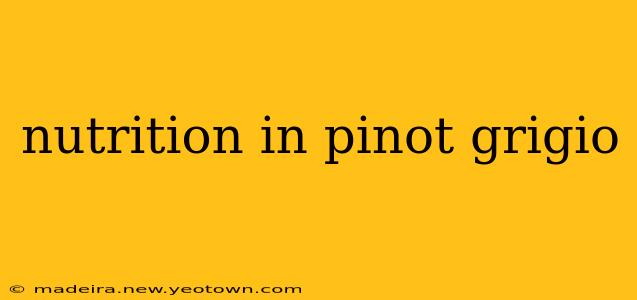Pinot Grigio. The name conjures images of sun-drenched vineyards, crisp evenings, and sophisticated gatherings. But beyond its elegant appeal lies a question many wine enthusiasts, and health-conscious individuals alike, ponder: What's the nutritional breakdown of this popular white wine? Let's embark on a journey to uncover the nutritional profile of Pinot Grigio, dispelling common myths and providing a clearer picture of its place in a balanced diet.
What are the nutritional facts of Pinot Grigio?
A typical 5-ounce serving of Pinot Grigio contains surprisingly few calories, typically around 120-130. The exact calorie count can vary depending on factors such as the grape's growing conditions, fermentation process, and even the specific winery. However, the overall calorie count remains relatively low compared to other alcoholic beverages. Beyond calories, Pinot Grigio contains trace amounts of carbohydrates and minimal fat and protein, making it negligible in terms of macronutrient contribution to a daily diet. It's important to remember that these are estimates, and always check the nutritional information provided by the specific brand you're consuming.
Does Pinot Grigio contain any vitamins or minerals?
While not a significant source of vitamins and minerals, Pinot Grigio does boast some trace amounts. The presence of these nutrients is often linked to the grapes themselves and the soil in which they are grown. Expect to find small quantities of minerals such as potassium and antioxidants. These antioxidant compounds, primarily polyphenols, are linked to potential health benefits, but more on that later. However, it’s crucial to understand that relying on wine for your daily vitamin and mineral intake would be wholly insufficient.
How many carbs are in a glass of Pinot Grigio?
The carbohydrate content in a 5-ounce serving of Pinot Grigio is typically very low – around 4 grams or less. The majority of these carbohydrates come from natural sugars present in the grapes. This low carb count is important for individuals following low-carb diets or managing their blood sugar levels. However, it's essential to remember that the alcoholic content can still affect blood sugar levels differently for some people, so moderation remains key.
Is Pinot Grigio good for your health? What are the potential health benefits?
The potential health benefits of Pinot Grigio, like with most alcoholic beverages, are largely tied to the moderation principle. Studies suggest that moderate consumption of wine, including Pinot Grigio, might be associated with certain health benefits. Some of these are attributed to the presence of antioxidants, which are believed to offer protection against cell damage caused by free radicals. However, these benefits are not a guarantee and excessive consumption could negate any potential positives and even lead to serious health problems. Always consult with a healthcare professional before making any dietary changes based on information found online, especially concerning alcohol consumption.
Are there any downsides to drinking Pinot Grigio?
While moderate consumption might hold some potential benefits, the downsides of excessive Pinot Grigio consumption are significant. Overindulging in alcohol, regardless of the type, can lead to a range of health problems, including liver damage, increased risk of certain cancers, weight gain, and various mental health issues. It's also important to be mindful of the potential for alcohol to interact negatively with certain medications. Always drink responsibly and in moderation.
Conclusion: Enjoy Responsibly
Pinot Grigio, with its low calorie and carbohydrate content, presents a relatively low-impact alcoholic beverage choice. However, it's crucial to remember that the nutritional value is minimal, and the potential health benefits are heavily contingent on moderate consumption. Enjoy the exquisite taste responsibly, mindful of the potential impacts on your overall health and well-being. Don't let the allure of the grape overshadow the importance of responsible drinking habits.

